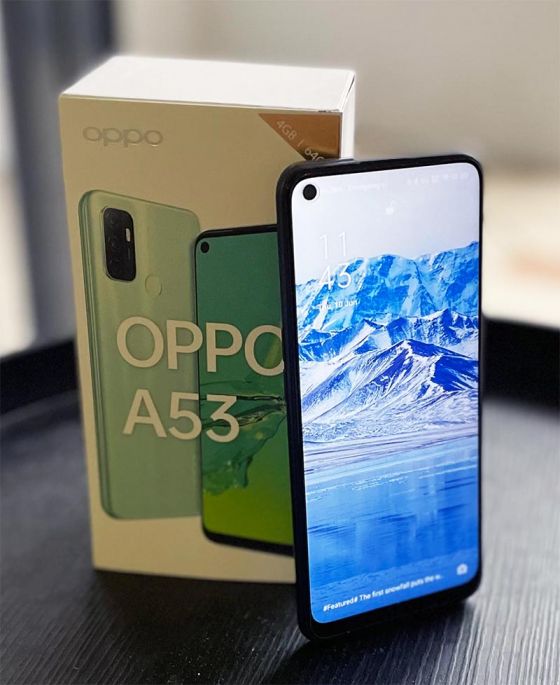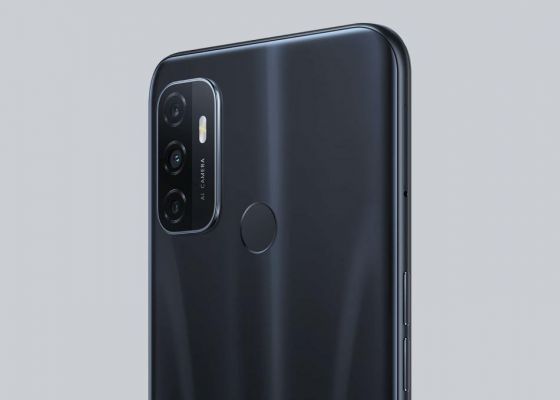A multi-time winner of Canstar Blue’s Most Satisfied Customers award for smartphones, OPPO has risen from being a little-known challenger brand to an increasingly popular choice for Aussie phone users. OPPO offers a range of devices for every budget, from lower-end affordable phones to premium models such as the Find X3 series.
The OPPO A53 falls on the cheaper end of the spectrum, coming in at $259 outright. OPPO touts the phone as a ‘ready for anything’ all-day device with an ultra-smooth display, and it seems ideal for the on-the-go user who wants an affordable phone with long-lasting battery life. We’ve put the A53 to the test over several weeks – read on to find out if this is the cheap OPPO phone for you.
Table of contents
- OPPO A53: features and specs
- OPPO A53: design
- OPPO A53: performance and battery
- OPPO A53: cameras
- Is the OPPO A53 worth buying?
- SIM-only phone plans
OPPO A53: features and specs

Here’s a quick list of the key features and specifications of the OPPO A53:
- Priced from $299
- 6.5-inch x 1600 LCD display
- Triple rear cameras (2-megapixel macro lens, 2-megapixel depth camera, 13-megapixel main camera)
- 8-megapixel front camera
- 5,000mAh battery
- Qualcomm Snapdragon 460 processor
- ColorOS 7.2 (based on Android 10)
- 64GB storage with up to 256GB expandable memory via microSD
- 90Hz refresh rate
OPPO A53: pros
- Excellent battery life
- Great design
- Affordable price
OPPO A53: cons
- Touchscreen issues
- Performance average for this price point
- No full HD screen
Design
When it comes to phone design, OPPO rarely makes a misstep – even the company’s lower-priced models suggest quality, and the A53 is no exception. Available in Electric Black and Mint Cream, the device’s rear offers what OPPO is calling a ‘3D iridescent wave design’, or a range of subtle pleats that reflect the light in a style reminiscent of tumbling ocean waves. It’s a pretty phone, and feels great in the hand, although for me personally it didn’t quite feel comfortable enough for easy one-handed use.
The OPPO A53 features a power button on the mid-right side, along with volume controls on the left, and retains a headphone jack along the bottom by the speaker – good news for potential buyers that like the option of using traditional earphones, rather than going wireless. It’s a fairly standard weight for a larger phone, with a 6.5-inch display and a 720 x 1600 resolution.
The lower resolution is a downside for users looking for a seriously high-definition phone experience, and you may notice the difference compared to devices with sharper screens. However, the A53 does pack a 90Hz refresh rate, meaning it’s a cut above the usual 60Hz inclusion you’ll find on most phones at this price point. Auto-refresh is enabled, meaning the device will switch between 90Hz and 60Hz where necessary to conserve battery; however, you’re free to manually select 90Hz-only if you want a smoother experience for gaming or viewing media.
Overall, the screen ticks the boxes and offers a decent display, and the sound is better than expected. OPPO has included dual stereo with Dirac automatic audio optimisation, so music and podcasts come through nice and clear, both via headphones and from the speakers themselves. Audiophiles may be left wanting, but for a $300-ish device the A53 delivers good sound and a all-round reliable media performance.
Other notable features include microSD support, giving you up to 256GB of extra storage in addition to the 64GB of on-board space, and a rear fingerprint sensor just above the top centre. Included in the box is a charger, USB-C cable and earphones, plus a plastic protective case – you’ll definitely want some sort of case for this device, as the A53 isn’t certified water or dust-proof.

Performance and battery
The OPPO A53 includes a fairly average chipset, offering a Qualcomm Snapdragon octa-core processor with speeds of up to 1.8GHz. While it’s not constantly slow, there were definitely signs of struggle during certain activities: opening apps (particularly YouTube), switching between tasks, and juggling multiple tabs all came with lag at some stage. If you’re big on multi-tasking and low on patience, this is not the phone for you, but users with simple needs who don’t require a heavy-duty processor should manage fine.
The A53 comes loaded with OPPO’s ColorOS 7.2, the company’s Android-based mobile operating system. This version builds on Android 10, and offers a simple interface that isn’t packed with the bloatware you’ll often find in tweaked versions of software. It’s easy to use if you’re an existing Android pro, and offers plenty of time-saving features, such as Smart Assistant, Smart Sidebar for quick access to most-used apps, and Clone Phone to quickly transfer data and media to your device. Privacy features such as Private Safe and App Lock are also great for keeping your personal info secure, and Multi-User Mode is ideal for separating your work and private life if you’re using a single device for both.
However, I had consistent issues with the responsiveness and general usability of the A53’s touchscreen, and found myself frequently having to tap or swipe multiple times to open apps or make selections. Whether this came down to a problem with the software or just user error isn’t clear, but no amount of changing settings and adjusting accessibility could eliminate the problem. As someone who’s used to an impressive performance from OPPO phones regardless of the price point, this was a souring experience for an otherwise satisfactory low-cost smartphone.
In better news, one big plus for the A53 is its battery life, which held up through the usual daily activities such as emailing, messaging, and social media use. The A53’s massive 5,000mAh battery is one of its more impressive specifications, and considering the type of user that’s likely to pick up this device, somewhat ‘extra’ – it’s a awesome feature, although not a necessary one. Still, it’s a huge pro if you want a device that you will take you from your morning alarm and all through your day without the need for a power top-up, and features such as SuperPower Saving Mode and standby optimisation will help to keep your battery going strong.
If you do need to recharge ASAP, the A53 is also compatible with 18W fast charging, so you can push your battery back into the black in as little as 15 minutes. However, unless you’re a heavy-duty user or simply forget to plug your phone in overnight, you’ll probably find that the A53 is fine to get you through the typical work or play day, especially with power-saving features enabled and your screen’s refresh rate on auto-mode.
Cameras
The A53 offers three cameras in the rear, which has become almost standard for devices across mid and high-range price points. OPPO’s setup includes a 13-megapixel main camera, 2-megapixel macro lens, and a 2-megapixel depth sensor, giving users a little variety and some extra oomph to close-up shots.
You’ll find a range of shoot modes on the A53’s main cameras, including panorama, portrait, and time-lapse. If you’re using the front camera, you can also select from filters and extras such as Bokeh and AI beautification, features designed to blur backgrounds and smooth your facial features respectively.

While the camera shutter speed can be slow to react – and shots don’t appear too impressive through the on-screen viewfinder – most pictures turn out fairly clear and focused once processed. Your best bet for the A53 is simple daylight photography, as the lack of a night mode means low-light shots are dark, dull and disappointing.

Colour accuracy isn’t perfect, but the A53 can deliver some fairly bright shots with good lighting. Macro mode is fun for getting closer to your subject, but isn’t on par with the high-quality macro lenses found in more expensive devices.

Overall, the A53’s cameras are more or less what you’d expect from a cheaper device, although a little underwhelming considering the specs competitors have packed in at a similar price point.
Is the OPPO A53 worth buying?
If you’re after a simple, reliable phone that will see you through from breakfast to bedtime, the OPPO A53 mostly delivers on the basics. The big downside is the sometimes-slow performance and touchscreen issues, which could be a real source of frustration for owners used to faster multi-tasking and a more seamless software experience. If you’re coming from a more expensive model, or you’re looking for a phone that can handle heavier app use and gaming, you’re much more likely to feel let down by the A53’s ‘relaxed’ processing speeds and touchy display.
On the other hand, if all you need is a powerful battery, decent display and a good set of speakers, the OPPO A53 ticks your boxes. But considering the phone’s weaknesses, you may want to consider other, better-reviewed devices in the sub-$300 price range, including other OPPO models. For example, the OPPO A15 has a smaller battery (4,230mAh, versus the A53’s 5,000mAh), but is fine for all-day use, and comes with a comparable $239 price tag.
Other devices in the under-$300 category you may want to consider include the Samsung Galaxy A11, the Vivo Y30, the Motorola G9 Play, and the Realme C12. If you’re happy to shell out a little more cash, the $350-ish Nokia 5.3 and Nokia 5.4 also offer good performance and strong battery life, and are good options if you prefer a well-established brand name.
While the OPPO A53 is a pretty phone with a good-sized screen and faster-than-average refresh rate, buyers may find that display and design alone isn’t quite enough to make up for the device’s performance shortcomings. If speed and ease of use are important to you, skip the A53’s good looks and shop around for a device that offers a faster, smoother user experience.
SIM-only phone plans
If you’re planning on buying the OPPO A53 or any other smartphone outright, you’ll need to pair it with a SIM-only mobile plan. Check the tables below for a selection of postpaid and prepaid mobile deals.
Here is a selection of postpaid plans from Canstar Blue’s database with a minimum of 20GB of data, listed in order of standard cost, lowest to highest, then by data allowance, largest to smallest. Try using our mobile phone plan comparison tool to see a wide range of plans from other providers. This table includes products with links to referral partners.
Here is a selection of prepaid plans from Canstar Blue’s database with a minimum of 10GB of data each month, listed in order of standard cost, lowest to highest, then by data allowance, largest to smallest. If you want to compare a larger range of offers from other providers, use our phone plan comparison tool. This table includes products with links to referral partners.
Related articles
- Cheap phones compared: $200 vs $300 vs $400 phone review
- OPPO A15 review: a surprising performance for a cheap price
- Nokia 5.4 review: a value-packed phone for under $400
- Realme 7 5G review: 5G at an affordable price
Header image: OPPO
Product used for review/testing was a free sample provided by OPPO.


Share this article